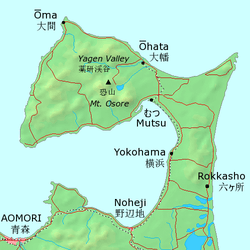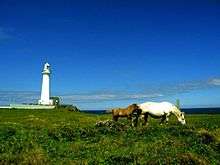Shimokita Peninsula
The Shimokita Peninsula (下北半島 Shimokita-hantō) is the remote northeastern cape of the Japanese island of Honshu, stretching out towards Hokkaido.
Cities
Other destinations
- 🌍 Mount Osore — in Japanese folklore, the entrance to Hell
- 🌍 Yagen Valley — scenic and almost uninhabited
Understand

Shaped like an axe pointing west, the peninsula has a thin "axe handle" connecting the mountainous "axe blade" to mainland. The coasts maintain a thin scattering of population but the interior is as remote a region as you can find in Japan. The largest population center is the drab town of Mutsu.
Get in
No matter how you look at it, Shimokita is a long way from anywhere.
By air
The closest airports are in Misawa and Aomori; from there you'll have to take a train or bus. Misawa has direct service to Tokyo and Osaka; Aomori also has direct service to Nagoya and Fukuoka.
By ferry
Tsugaru Kaikyo Ferry offers a service from Hakodate on Hokkaido to Ōma at the northwestern tip of the peninsula. There are between two and four services per day, depending on the season. Drivers and bikers are encouraged to make reservations in advance, especially in high season. The current fare for one foot passenger is ¥2200 one-way. There are no buses or taxi ranks direct from Oma ferry port; either reserve a taxi in advance, or ask the taxi drivers which are waiting for passengers who have reserved. Otherwise, there are bus stops in the town along a route leading up to Capr Oma (Oma-zaki). Buses are infrequent.
Mutsu wan Ferry offers service from Wakinosawa to Kanita in Tsugaru Peninsula, crossing Mutsu Bay.
By train
The JR Ominato Line from Noheji (on the Aoimori Railway) travels up the axe handle to Mutsu. Direct Shimokita rapid service trains are available from Aomori and Hachinohe (the former being the northern terminus of the Tohoku Shinkansen line from Tokyo). The Ominato Line can also be reached by taking the Aoimori Railway from Hachinohe to Noheji.
Get around
Most tourists in the area either bring or rent cars. Getting around without your own set of wheels is not easy, especially off-season.
Intermittent buses do connect the main towns. If you travel by bus, be sure to pick up an Aomori Card (available to passport-showing foreigners only) in either Aomori or Mutsu's tourist office for 50% discounts on travel.
The other (often faster) option is hitchhiking. Be prepared for long waits, though, as many roads on the peninsula are very lightly trafficked, even in high season.
On the west side of the peninsula, ferries run between Wakinosawa, Sai and several points in between.
Talk
Shimokitans have their own dialect of Japanese, known as Shimokita-ben (下北弁), which keeps linguists and other visitors scratching their heads at times. Some typical Shimokitan words and phrases include:
| English | Standard Japanese | Shimokita dialect |
|---|---|---|
| I | watashi | wai, wara |
| my place's, mine | watashi no tokoro no | waihono, wahono |
| please | -shite kudasai | -samai |
| ..., isn't it? | -ne | -nishi |
| A little | sukoshi | wansuka |
Standard Japanese is, however, widely spoken.
See and do

- Yagen Valley is one of the most beautiful mountain valleys in all Japan, featuring free hot springs and campgrounds.
- Mount Osore is the mythical Japanese entrance to hell, a desolate wasteland of sulphuric springs.
- It is possible to visit Cape Oma, the northernmost point of Honshu, without your own transport if you arrive on the 11:10 ferry into Oma and can get a taxi to Oma-zaki (the cape), then continue south to Mutsu. A bus which goes from Oma to Mutsu calls at the Cape at 11:58, but does not stop for photos etc. breaks. The Cape itself features several touristy photo opportunities, lots of small shops selling gifts, tuna and squid, plus good views of Hokkaido.
- Cape Shiriyazaki is the most northeastern point of Honshu. It features beautiful sea cliffs and "wild horses" you can get close enough to pet. In the winter the gate to the cape is locked and you must walk and the horses are kept in a pasture more sheltered from the harsh winter wind, it is still accessible but not right on the water. During the summer you can drive out onto the cape and see the horses and the lighthouse.
Eat and drink
The local speciality is squid, particular squid ink ramen noodles.
Connect
Mutsu's tourism office is very helpful to the few foreigners who make it to this neck of the woods, although English ability and material is limited.